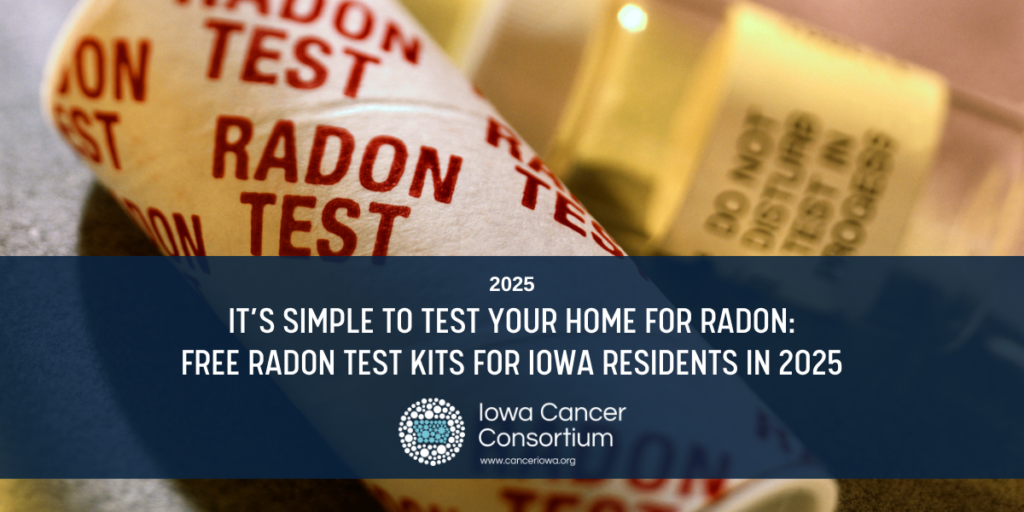It’s Simple to Test Your Home for Radon: Free Radon Test Kits for Iowans in 2025

1/13/25 Update: The American Lung Association (ALA) is out of free test kits at this time. Contact your county’s public health department to see if they offer free or discounted test kits. Otherwise, they can be purchased from ALA or any hardware store.
Written by Jill Heins-Nesvold, American Lung Association
On average, Americans spend 90% of their time indoors, so indoor air quality is critical to the health of families. In indoor environments, the levels of some pollutants are often two to five times (and sometimes as much as 100 times) higher than outdoor concentrations. Check out this brief video on indoor air quality and read last month’s blogpost, Winter Air Care: Improving Air Quality and Lowering Cancer Risk Indoors.
One indoor air pollutant is radon. Radon is a naturally occurring invisible, odorless gas that comes from the radioactive breakdown of uranium in soil, rock and water. Once inhaled, radon decays into radioactive particles. The particles attach to your lung tissue and become trapped inside your lungs after you exhale. These particles emit alpha radiation which strike lung cells and damage DNA. The damaged cells can become cancerous. Every year, over 21,000 people die in the United States from lung cancer caused by radon, including an estimated 400 Iowans. Learn more about radon through this brief video or fact sheet.
Elevated levels of radon are found in homes in every state, and in Iowa, radon levels are elevated in as many as 5 in 7 homes. The only way to detect radon is to test your home. Do-it-yourself radon test kits are easy to set up and are available for less than $20.
Free test kits are available to Iowa residents starting in January 2025, while supplies last, at Lung.org/radon-test. These free kits are provided by the Iowa Department of Health and Human Services and the American Lung Association. The free kits are for Iowa residents to use in their own homes, and are not eligible to be used for daycares, schools, or businesses.
Test kits can also be purchased at local hardware stores or from certified radon measurement professionals. Be sure to follow the instructions on the radon test kit package on exactly where to place the test in the lowest level of your home. It is recommended that homes are tested every two years for radon.
Radon levels are measured in pCi/L (picocuries per liter). 4.0 pCi/L is the level established by the U.S. Environmental Protection Agency (EPA) for action to fix the problem, and buildings that test at 2.0 – 4.0 pCi/L are advised to consider mitigation. The goal is to get your radon level to the lowest possible level.
If you have an existing home with elevated levels of radon, you can fix the problem by having a radon mitigation system installed. A radon mitigation system consists of a vent pipe, fan, and the sealing of cracks in in the baseline floor and foundation. This system collects radon gas from underneath the foundation and vents it to the outside of your home. If you need to have a radon mitigation system installed, hire a certified radon mitigation professional. See a list of certified radon mitigation professionals in Iowa here. Mitigation systems can cost between $1,000 – $2,500. After a mitigation system is installed, test your home within 30 days of the mitigation system installation and then every 2 years. Detailed information about radon reduction in your home or building can be found in EPA’s Consumer’s Guide to Radon Reduction.
Considering purchasing or building a new home? Radon testing should be a normal part of the home-buying process. If building a new home, a mitigation system should be installed, tested within 30 days of installation, and then every two years. If purchasing an existing home, seek information about the radon levels in the home during the real estate transaction. Check to be sure that the test results are recent (within the past two years) and conducted by licensed and/or certified professionals. The only way to know if radon poses a risk is to test one’s home or building. Testing homes for radon is easy, quick, and can be part of a regular home inspection. Qualified professionals can complete short-term testing in as little as 48 hours for about $100 to $250. The American Lung Association has a radon awareness toolkit and additional resources for real estate professionals.
January is National Radon Action Month. Testing your home for radon is a low-cost assurance to keep you and your family safe. Order your test kit today.
About the Author
 Jill Heins-Nesvold serves as Nationwide Senior Director of Health Systems Improvement and Indoor Air Quality with the American Lung Association.
Jill Heins-Nesvold serves as Nationwide Senior Director of Health Systems Improvement and Indoor Air Quality with the American Lung Association.
